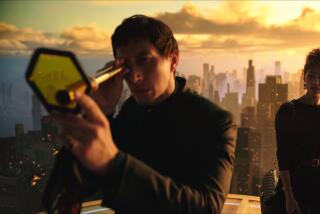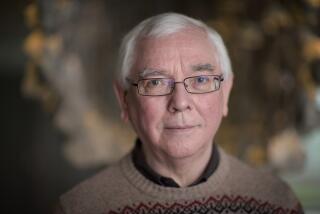Review: ‘Of Time and the City’
- Share via
“Of Time and the City” is a difficult film to describe but a distinct pleasure to experience. A cinematic essay, a documentary and a memory piece, all at the same time, it is more than anything an unapologetically poetic film that allows British director Terence Davies to ruminate on Liverpool, the city of his birth, and his own life and times there.
If you’ve seen Davies’ autobiographical dramatic films, especially 1988’s brilliant “Distant Voices, Still Lives” and its sequel, “The Long Day Closes,” you know how effective a director he is when dealing with his past as the youngest of 10 children in a difficult household.
While “Of Time and the City” is a documentary and, more than that, one in which 80% of the footage is archival material such as newsreels, it displays the same virtues that made the director’s earlier fiction films so memorable.
One such gift is Davies’ exceptional eye, the ability to pick out the most eloquent visual sequences from a wealth of choices. Another is his almost unparalleled ability to marry sound with image, to mix and match his clips with affecting music, especially popular songs of the period.
On one level, the tone of “Of Time and the City” is one of regret, sadness at the disappearance of the working-class city the filmmaker grew up in. Davies begins the film with a quote from A.E. Housman’s “A Shropshire Lad” that emphasizes this melancholy that the past is no more: “That is the land of lost content / I see it shining plain/ The happy highways where I went / And cannot come again.”
But filmmaker Davies, who narrates the film himself in a gruff, acerbic voice, is not one for sentimental nostalgia. Yes, he loves and misses the Liverpool of his youth, on display in that lovely black-and-white newsreel footage, but he still boils with fury at some of what he experienced there, and he’s far from shy about expressing his resentments. Sometimes that anger sounds grating and overwrought, but it also provides a stern counterpoint to the beautiful images and melodies it accompanies.
Davies, raised Catholic, is especially vocal about his experiences with organized religion, striking out against “the years wasted in useless prayer.” He’s none too happy with the monarchy either, lambasting the extravagances of the future Queen Elizabeth’s wedding, calling it “The Betty and Phil Show.”
The director also has savage things to say about the anti-gay laws and practices of his England, but at the same time he puts together a marvelous sequence that marries spookily beautiful footage of hooded professional wrestlers with his own memories of the sexual feelings that seeing those men evoked.
Both in life and in “Of Time and the City,” cinema saved Terence Davies. He discovered the movies when he was 7 years old and “swallowed them whole . . . gorging myself with a frequency that would shame a sinner.”
Davies’ eye for footage no doubt stems from his lifelong love of the medium, and time and again, the images he has chosen for his film -- sequences of thronged ferries, huge stadium crowds or slow, dreamy pans of rows of houses -- couldn’t be more effective.
Improving on these visuals are the unerringly appropriate popular songs Davies has selected to play on the soundtrack, songs like the Spinners singing “Dirty Old Town” or Peggy Lee’s “The Folks Who Live on the Hill.” Most memorable is disturbing Korean War footage linked to the Hollies doing “He Ain’t Heavy, He’s My Brother.”
Most of all, Davies proves himself to be a poet of the commonplace whose art is the exalting of the everyday. He may rail against “the British genius for creating the dismal,” but his own work is anything but.
More to Read
The biggest entertainment stories
Get our big stories about Hollywood, film, television, music, arts, culture and more right in your inbox as soon as they publish.
You may occasionally receive promotional content from the Los Angeles Times.











